NR 283 (NR283)
Chamberlain School Of Nursing
Page 3 out of 35 results
Sort by

-
NR 283 Pathophysiology Test Question Bank (Latest): Chamberlain
- Exam (elaborations) • 356 pages • 2023
-
- $27.48
- + learn more
NR 283 Patho Chamberlain-converted NR 283 Pathophysiology Test Question Bank / NR283 Test Question Bank / NR 283 Patho Test Bank (Latest): Chamberlain Chamberlain NR283 Test Question Bank (Exam 1, Exam 2, Exam 3, Final Exam) NR 283 Pathophysiology Test Question Bank / NR283 Test Question Bank / NR 283 Patho Test Bank (Latest): Chamberlain
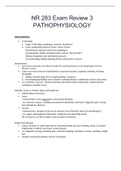
-
NR 283 Exam Review 3 PATHOPHYSIOLOGY
- Exam (elaborations) • 14 pages • 2022
-
- $13.00
- + learn more
Gastrointestinal • GI bleeding a. Upper GI bleeding: esophagus, stomach, duodenum b. Lower GI bleeding: jejenum, ileum, colon, rectum Hematemesis: bloody vomit (from esophagus) Hematochezia: bright-red blood (colon, rectum “hemmoroid”) Melena: burgundy color (old blood; jejunum) Occult bleeding: hidden bleeding (blood cells present in feces) Hiatal Hernia: • part of the stomach protrudes through the opening (hiatus) in the diaphragm into the thoracic cavity • Cause: too muc...
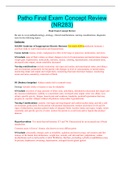
-
Patho Final Exam Concept Review (NR283)
- Exam (elaborations) • 25 pages • 2022
-
- $14.00
- + learn more
Be sure to cover pathophysiology, etiology, clinical manifestations, nursing considerations, diagnostic tests for the following topics: Endocrine SIADH- Syndrome of Inappropriate Diuretic Hormone Too much ADH (antidiuretic hormone ) secretion leads to water intoxication and hyponatremia Causes include trauma, stroke, malignancies (often in the lungs or pancreas), medications, and stress S/S include signs of fluid volume overload, changes in level of consciousness and mental status changes, w...
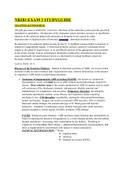
-
NR283 EXAM 3 STUDYGUIDE
- Exam (elaborations) • 42 pages • 2022
-
- $17.00
- + learn more
All right guys here is endocrine! Overview- functions of the endocrine system provide growth & reproductive capabilities. Dysfunction of the endocrine system includes excessive or insufficient function of the endocrine gland with alterations in hormone levels caused by either hypersecretion or hyposecretion of hormone abnormal hormone levels. Dysfunction of an endocrine gland can also be due to: 1) feedback systems failure to function or respond to inappropriate signals,...
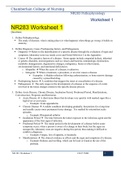
-
NR283 Worksheet 1
- Exam (elaborations) • 13 pages • 2022
-
- $13.00
- + learn more
1. Define Pathophysiology. • The study of diseases; what is taking place (or what happens) when things go wrong; it builds on anatomy. 2. Define Diagnosis, Cause, Predisposing factors, and Pathogenesis. • Diagnosis Refers to the identification of a specific disease through the evaluation of signs and symptoms, laboratory tests (see inside cover and Ready Reference 5 in the Appendix). • Causes The causative factors of a disease. Some agents include congenital defects, inher...
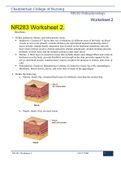
-
NR283 Worksheet 2.
- Exam (elaborations) • 16 pages • 2022
-
- $14.00
- + learn more
1. Define epidermis, dermis, and subcutaneous tissue. • Epidermis: Consists of 5 layers that vary in thickness @ different areas of the body; no blood vessels or nerves are present; contains melanocytes (specialized pigment-producing cells);5 layers include: stratum basale (innermost layer located on the basement membrane and only layer where mitosis occurs), stratum spinosum, stratum granulosum, stratum lucidum (present primarily in thick skin), and the stratum corneum (outer most layer). ...
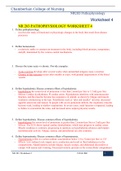
-
NR 283 PATHOPHYSIOLOGY WORKSHEET 4
- Exam (elaborations) • 23 pages • 2022
-
- $15.00
- + learn more
1. Define pathophysiology. - involves the study of functional or physiologic changes in the body that result from disease processes 2. Define homeostasis. - a relatively stable or constant environment in the body, including blood pressure, temperature, and pH, maintained by the various control mechanisms 3. Discuss the terms acute vs chronic. Provide examples. - Acute rejection develops after several weeks when unmatched antigens cause a reaction - Chronic or late rejec...

-
NR 283 PATHOPHYSIOLOGY EXAM 2 STUDY GUIDE
- Exam (elaborations) • 8 pages • 2022
-
- $10.00
- + learn more
1. Viral infections a. Take antiviral to reduce viral shedding (can’t proliferate) 2. Autoimmune skin disorders a. Shingles b. Pemphigus blisters i. 2 forms = vulgaris & foliaceus ii. Antibodies disrupt the cohesion between the epidermal cells causing blisters to form iii. Treatment = systemic glucocorticoids such as prednisone & other immunosuppressants 3. Psoriasis a. A chronic inflammatory skin disorder caused by abnormal T cell activation b. Cells are shedding epithelium a lo...
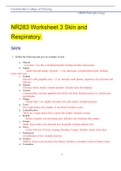
-
NR283 Worksheet 3 Skin and Respiratory.
- Exam (elaborations) • 6 pages • 2022
-
- $10.00
- + learn more
1. Define the following:and give an example of each a. Macule Less than 1 cm, flat, well defined border. Includes freckles and measles. b. Papule Small firm and usually elevated, < 1 cm, solid mass, circumscribed border. Includes moles and warts c. Nodule Elevated, solid, palpable mass, 1-2 cm. Includes small lipoma, squamous cell carcinoma and fibroma. d. Pustule Elevated, lesion, usually contains purulent. Includes acne and impetigo e. Vesicle ...
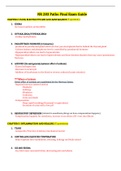
-
NR 283 Patho Final Exam Guide
- Exam (elaborations) • 12 pages • 2022
-
- $13.00
- + learn more
1. EDEMA Increased capillary permeability 2. HYPOKALEMIA/HYPERKALEMIA -Cardiac dysrhythmias 3. PARATHYROID HORMONE (4 Scenarios) -produced in parathyroid gland which are four pea-sized glands that lie behind the thyroid gland -Calcium balance and phosphorus level is controlled by parathyroid hormone -Hypoparathyroidism can lead to hypocalcemia -Hyperparathyroidism can lead to hypercalcemia and bone demineralization that may cause spontaneous fractures. 4. ACIDOSIS (He said gener...

That summary you just bought made someone very happy. Also get paid weekly? Sell your study resources on Stuvia! Discover all about earning on Stuvia


